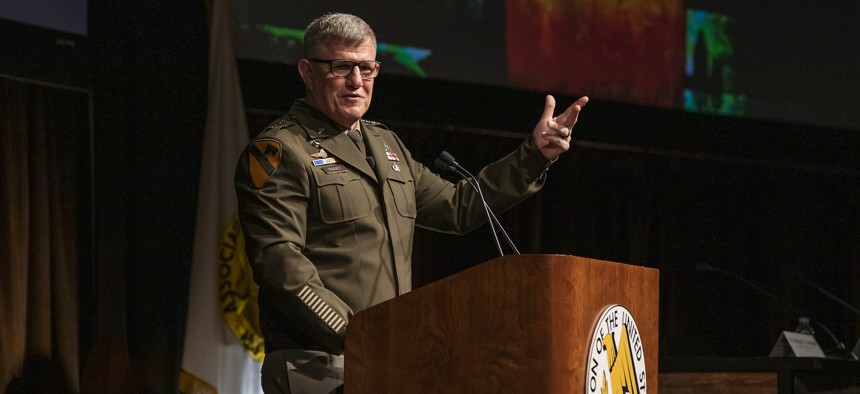
Gen. James Rainey, commander of U.S. Army Futures Command. U.S. Army / Joseph Kumzak
Army looks to field loitering munitions next year
The Army is also experimenting with robots integrated with platoons at Fort Moore and Irwin.
The Army may start fielding loitering munitions by the middle of next year amid a push to adopt innovative technology seen in Ukraine, the head of Army Futures Command said Wednesday.
“I think you’ll see those start delivering in the first half of next year,” Gen. James Rainey said at a media roundtable at the Pentagon. The Army sees the acquisitions process as an “iterative” task, in which the munitions become better and better with each purchase, he added.
The Army in July announced a program for equipping Army brigades with loitering munitions. The effort, dubbed Project LASSO, seeks to put more weapons capable of destroying enemy tanks into the hands of average infantry units.
The Army chose AeroVironment’s Switchblade 600 as the first drone to test for Project LASSO, Army acquisition chief Doug Bush said in October. The units doing the tests will start with more than 100 Switchblade 600s. The Army will invite other companies to compete in follow-on tests, Bush said.
Both Russia and Ukraine have made heavy use of loitering munitions, also known as suicide drones, in the ongoing war. Ukraine’s arsenal includes Switchblade 600s as well as cheaply made hobby racing drones fitted with explosives.
Rainey said that his timeline for fielding loitering munitions applied both to Project LASSO and other programs he did not name.
Unlike the years long-process normally associated with fielding new weapons systems, Rainey said the Army is moving quickly with loitering munitions because they are far simpler weapons than logistically complex and maintenance-heavy vehicles.
“If you have to build a training facility, if it comes with a big motor pool, backside sustainment thing…that automatically puts it in the deliberate modernization category,” Rainey said. Loitering munitions, by contrast, can come through the ammunition system, and units can use them “with a very minimal amount of training.”
Rainey also floated the idea of acquiring cheap and easy-to-use drones for Army units through rapid supply channels, such as using the Army’s class nine supply list, which is more typically reserved for things like spare parts and radios.
Speaking at an earlier appearance Wednesday at an Association of the United States Army, Rainey also gave more detail on previously announced plans to test new technologies inside Army units.
One platoon at Fort Moore in Georgia is experimenting with integrating robots in urban operations, he said. These robots include some with smoke generators and jammers, ground drones for exploring buildings, and drones capable of dropping other robots equipped with cameras onto the tops of buildings.
“No human was the first thing to enter any building,” Rainey said about one recent test, adding that robots may be useful for casualty evacuation.
The Army is also testing out robots with the units playing the opposing forces during exercises at the Fort Irwin national training center, Rainey said. These robots will work with light and armored formations, said Lt. Gen Ross Coffman, Rainey’s deputy at Army Futures Command.




